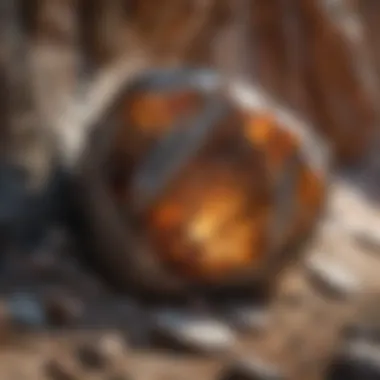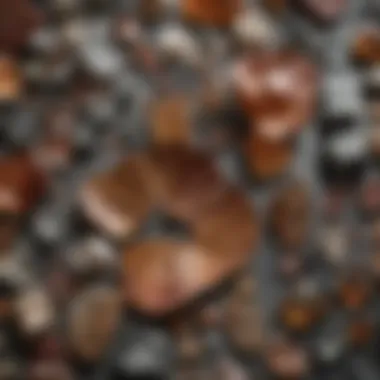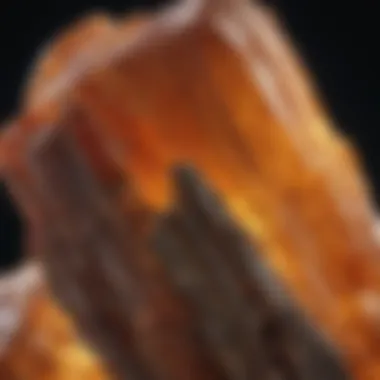The Vital Role of Rutile in Mineralogy and Collecting


Intro
Rutile is more than just a mineral; it stands as a pivotal cornerstone in mineralogy. This article will provide a detailed examination of rutile's crystallographic characteristics, its occurrence in nature, and its economic significance. Knowledge about rutile is valuable not just for geologists and mineralogists but also for collectors who have an affinity for unique specimens. Understanding rutile requires a multidisciplinary approach that touches upon geology, industry, and aesthetics.
Rock and Fossil Identification
Identifying rocks and fossils in the field can enhance one’s understanding of geology as well as contribute to a respectable collection of rutile samples. Considerations in this activity encompass different types of geological formations, characteristic markings, and essential tools for successful identification.
Types of Rocks and Fossils
Generally, the rocks where rutile is found are classified into three categories:
- Igneous Rocks: Formed from cooled molten rock, igneous rocks like granite often harbor rutile crystals within them, providing insight into the high temperatures involved in their formation.
- Metamorphic Rocks: Rutiles often occur as metamorphic minerals in schist and gneiss, whereby conditions of heat and pressure have altered the original rock type, resulting in varied crystallographic against each specimen.
- Sedimentary Fossils: While rutile itself is not a fossil, certain sedimentary rock formations may have traces of rutile deposits that suggest ancient geothermal activity.
Characteristics to Look For
When identifying rock specimens, one needs to observe crucial features such as:
- Luster: Rutile crystals often appear shiny or metallic, distinguishing them from other minerals.
- Striations: Look for parallel lines on rutile crystals as these can provide information on the growth patterns and the conditions under which the mineral formed.
- Color: Rutiles typically have a reddish to golden hue, which can make them stand out in mixed mineral samples.
Tools for Identification
Utilizing the right tools enhances the identification process:
- Hand Lens: This lets collectors get a close look at details that the naked eye may miss.
- Field Guide: A rock identification guide can be pivotal in knowing what mineral you are looking at in situ.
- Geological Hammer: This is a must for splitting rocks to reveal secrets inside.
Collecting Tips and Techniques
Gaining knowledge about rutile and how to effectively collect related specimens privileges both novice and seasoned collectors. The acquiring approach can vary, but here are some recommended practices:
Best Practices for Collecting
- Research areas where rutile is easily found; this is often where geological surveys indicate high concentrations.
- Always ask for permission when nearing private land. Ethical collecting practices foster good relationships in the community.
Locating Prime Collecting Sites
- Look for sites with ancient geothermal activity as these often yield good rutile samples.
- Online platforms, such as subreddit to find r/mineralology, offer insights on specific locations chosen by other collectors.
How to Safely Extract Specimens
- Always ensure the area is stable before chiseling away stones; an accident can ruin a good find.
- Use safety goggles to prevent any debris from causing harm.
Preservation and Display
Collecting is just the start; preserving and displaying your finds dramatically affects long-term satisfaction. Here are necessary points to consider:
Techniques for Preserving Rocks and Fossils
- Clean specimens with a soft brush to remove dirt—avoid using harsh chemicals as they can damage minerals.
- Expertly label each stone or fossil with where it was found to assist future identifications.
Proper Storage Methods
- Store your specimens in silica gel bags to prevent moisture buildup, which can be detrimental.
- Use small cases with UV protection to shield specimens from light damage over time.
Creative Display Ideas
- Arrange your rutile samples in a shadow box, where natural light can highlight their brilliance strategically.
- Consider themed collections, such as showcasing minerals with similar origin stories or geological features.
Geological Insights
Embedded within the mere aspects of collecting are profound geological insights derived from the specimens. Studying rutile not only embellishes our understanding but sets a baseline for several geological discussions.
Geological Formations and Processes
Recognizing the formations that host rutile allows enthusiasts to appreciate the environmental conditions that created them.


Historical Significance of Rocks and Fossils
These insights about geological periods give insight into the age and nature of the deposits. Case studies from find locations reveal the climatic and tectonic activities active at various times.
Notable Discoveries in the Field
Rutile pieces display properties that cast light on historical mining operations. Various localities around the world are famous for their significant contributions at diverse moments in mineralogy.
In sum, rutile attracts interest not just for its beautiful forms but also for its role in Earth science and the memories held in every crystal the can inspire through exploration.
Understanding Rutile
Rutile is a significant player in mineralogy, given its diverse applications and its implications in various geological contexts. This section aims to illuminate the essence of rutile, delving into its definition, composition, and crystallographic characteristics. Understanding the core elements of rutile sets the stage for appreciating its broad impact, especially for those who collect this mineral.
Definition and Composition
Rutile is primarily composed of titanium dioxide (TiO2). This common but noteworthy mineral crystallizes in the tetragonal system, forming beautifully distinct crystals. The name "rutile" is derived from the Latin word "rutilus," which means red. This refers to one of its most notable visual features, where product shades can display a range of colors including red, yellow, and even black.
Chemically, rutile has a significant role in various industrial processes. As one of the main sources of titanium, it is used to produce high-performance materials. Particularly relevant to collectors, knowing its composition enhances understanding of how rutile interplays with other minerals in various geological settings.
Crystallographic Characteristics
Crystal System
The crystallographic analysis of rutile reveals its placement within the tetragonal crystal system. Its unique structural arrangement allows for the formation of stunning, needle-like crystals that can be quite striking. The tetragonal system promotes crystallization that is often elongated, providing collectors with remarkable specimens to appreciate.
Key characteristics of the tetragonal crystal system include:
- Two equal axes
- Reaction with linear designs
- Symmetry that influences light diffraction
This specific arrangement contributes substantially to rutile's appeal and applications. It offers unique optical properties like birefringence, making it a valuable discovery in geology.
Habits and Forms
Rutile manifests in a variety of habits and forms. While it frequently appears as thin prismatic crystals, it can also exist as granular aggregates. The versatility in habits plays a significant role in mineral identification and collecting.
One of the more notable forms of rutile is as inclusions within quartz. This form is sometimes highly sought after in the collector's community due to how it enhances the aesthetic appeal of specimens. Understanding the habits and forms of rutile can inform collectors about potential mishandling dangers such as its tendency to break when subjected to pressure.
The diversity in habits contributes to rutile's charm in the collecting realm, ensuring that each piece can tell a unique geological story.
Geological Occurrence
Understanding the geological occurrence of rutile is essential for grasping its significance in mineralogy and collecting. Rutile can form through complex geological processes and its numerous deposits worldwide reveal its varied sources and applications. Recognizing these occurrences allows collectors and enthusiasts to appreciate the many layers that contribute to the formation of this noteworthy mineral.
Formation Processes
Metamorphic Processes
Metamorphic processes are critical in shaping rutile. During these processes, existing minerals undergo transformation due to factors like temperature and pressure. Here, rutile often forms as a product of the alteration of titanium-rich minerals. This makes metamorphism a key process for showcasing rutile's origin.
Most notably, the transformation often occurs in schists and gneisses, which can contain fine-grained rutile inclusions. Collector’s keen interest lies in these metamorphosed areas as they can yield striking varieties of rutile crystals. The ability of metamorphic processes to fonn rutile demonstrates vital geological dynamics.
Magmatic Processes
Magmatic processes present another interesting aspect for understanding rutile occurrences. These processes involve the solidification of molten rock, leading to the creation of several minerals. Rutile originates often from ilmenite and anatase, which crystallize when magma cools. This provides distinct crystal forms, showcasing rutile’s beauty through various vibrancies in color and structure.
Magmatic deposits are found in igneous rocks like granites and syenites. Such formations often contain richer hues that might attract collectors, highlighting rutile's aesthetic attributes. However, while the beauty of rutile in magmatic instances is noteworthy, over-exploitation in some areas can create concern over sustainability.
Global Deposits
Rutile deposits span across continents and can generally be analyzed for their scale and type. Understanding these deposits is important in the context of both economic usefulness and collector interest. Regions rich in rutile provide valuable opportunities for both commercial extraction and mineral collection for hobbyists.
Major Rutile Deposits
Major rutile deposits significantly guide the mineral economy. Regions like Australia, South Africa, and Brazil showcase substantial sources of rutile. These deposits are often mined, providing a steady supply for industries like aerospace and pigments. This mining has increased expectations for rutile availability.
For collectors, areas abundant in rutile offer opportune jaunts for exploration. Some deposits not only have commercially viable minerals but also produce distinctive crystal structures and colors that make them desirable.


Geographic Distribution
The geographic distribution of rutile underscores its global relevance. Various regions articulate a map of concentrated deposits, impacting collecting practices. Regions such as Australia formulate a natural focus, moving interest. Such formations provide essential reference points.
Additionally, country-specific mineral regulations can greatly influence collecting dynamics. States with minimal restrictions may encourage collectors, sunանքով making it all the more appealing. It is worth noting, however, that sustainability concerns and legal guidelines shape how collections are expanded.
Understanding the geological occurrence of rutile provides perspective on its importance in science, industry, and collecting.
Economic Importance
Rutile holds significant economic value due to its widespread applications. In various industries, rutile is known for its main component—titanium dioxide. This feature establishes luminary roles across sectors such as aerospace, automotive, and paints. Understanding these applications is essential not just for collectors but also for industrial stakeholders looking to make informed decisions regarding rutile-based materials.
Industrial Applications
Use in Titanium Production
Rutile is primarily valued in the extraction of titanium, one of the strongest yet lightweight metals known. This is central to the titanium production process, where rutile serves as a major mineral source. The purity of rutile influences the efficiency of titanium extraction. Given the escalating demand for titanium in aerospace applications, its role is increasingly significant.
Advantages of using rutile in titanium production include:
- High stability and resistance to corrosion,
- The potential for producing consistent high-grade titanium,
- Its availability in large deposits globally.
However, acquiring rutile can come with challenges, such as variability in quality and complications in mining procedures.
Role in Pigment Industry
Furthermore, rutile has a crucial role in the pigment industry. Artists and paint manufacturers favor rutile for its brightness and durability when mixed into products. The pigment rutile titanium dioxide is celebrated for its excellent covering ability and resistance to fading. Its application is not just limited to paints but extends to cosmetics and plastics.
Key aspects include:
- Non-toxic and environmentally friendly options make it a popular choice,
- Its high opacity maximizes pigment performance.
On the other hand, quality control is vital given that impurities can impact the color and durability of the final product, making it crucial for manufacturers to choose the right source of rutile.
Market Dynamics
Global Market Overview
The global market for rutile has been fluctuating, shaped by demand and supply dynamics. As industries grow, the need for rutile increases proportionally. New markets are emerging in regions where innovation drives economically sustainable practices. Key drivers include developments in production technologies and shifts in consumer preferences toward sustainable materials.
Notable insights from the current market scenarios encompass:
- Increasing preference for eco-conscious materials leading to robust markets,
- Geographic concentration of significant rutile deposits impacting trade patterns.
Pricing Factors
Pricing for rutile can be influenced by multiple factors. The rarity of high-purity rutile drives prices up due to its essential role in advanced applications. Additionally, geographical variance contributes to the discrepancies often observed in cost. Moreover, extraction costs and logistics impact market price fluctuations.
Critical pricing elements involve:
- Physical logistics-related to extraction and transportation,
- Economic regulations set by governments influencing trade practices.
Being aware of these pricing factors helps collectors and investors navigate their decisions competently.
Rutile and the Collector's Perspective
Rutile holds considerable appeal for mineral collectors owing to both its aesthetic and scientific characteristics. Its vibrant colors and unique formations entice collectors and enthusiasts alike. Moreover, rutiles are often collected as much for their geologic significance as for what they represent visually. Understanding rutile through the collector's lens informs individuals not just about the mineral but also about proper methods of handling and care which can maximize their investment, enjoyment, and longevity.
Aesthetic Qualities
Color Variations
Color variations are one of rutile's most captivating aspects. From deep reds to earthy browns and even striking yellows, the range of visible hues adds to its uniqueness in any collection. Collectors are often drawn to specific hues that resonate either with personal preference or their contextual display. The key characteristic of these color variations lies in the mineral's inherent composition and environmental influences during formation.
This spectrum of color enhances rutile's status as a sought-after mineral. Its subtlety paired with vibrancy creates disciplines within collecting specific to aesthetic philosophy. Some collectors may find that the diversity of color leads to more interpretative arrangements when creating displays. Limited editions based on striking color tones often fetch market values that reflect both rarity and visual appeal.


However, it is important to recognize that these color variations can also present challenges. Not all hues may represent high quality, or the best krystals of rutile. Understanding what each color denotes regarding the mineral's formation can greatly advantage a collector.
Luster and Transparency
Luster and transparency are additional aspects that contribute to rutile’s allure. The surface finish of rutile can range from adamantine to metallic, deeply influencing its visual appeal. Excellent luster in specimens often indicates high purity, making these particular pieces more desirable. Clear specimens of rutile presenting suitable transparency can also display inclusions like crystal shards that lead to fascinating visual effects.
A notable feature of rutile's luster is that it can significantly enhance the overall aesthetic of a collection. Transparent and bright specimens often gain the most attention in collector circles, frequently touted for their beauty in quality presentations. On the downside, the misconception that luster alone denotes superior specimens can lead to misunderstanding among novice collectors, emphasizing the need for a deeper knowledge before acquiring specimens.
Collecting Rutile
Best Practices for Collecting
When it comes to collecting rutile, best practices are fundamental for both achieving a quality assemblage and ensuring the safety of specimens. Well-informed collecting strategies protect the integrity of pieces and reinforce the sustainable pursuit of mineralogy. Key factors to implement include researching local laws prior to field collecting, employing appropriate tools for extraction, and understanding how locality influences mineral characteristics.
This devoted approach streamlines collections that have coherent mapping of origins and attributes. Factor such care to acknowledge the current geological impacts that present potential risks in collections and why reaching ethical goals holds meaning for the community within the gem and minerals sphere. Waste and pollution issues further make such practices essential in respect of miner resources and ensuring long-term availability.
Handling and Preservation Techniques
Proper handling and preservation techniques are crucial to maintaining_routes integrity and aesthetic value through time. Unlike durable minerals, rutile can be sensitive to scratches and decay which require strategic care to protect elements in the collection. Key feature techniques include using acid-free gloves, choosing appropriate storage environments, and regular monitoring for environmental factors that may affect mineral health.
By implementing rigorous handling techniques, collectors promote not only the longevity of individual pieces but also subsequently retourne value back to the overall market dynamics for rutile. Enthusiasts often find that preserving functionality for display needs requires dedicated upkeep much like educators recording their lessons. As with any aspect in mineral collecting, deliberate handling encourages crisp depths of insight into the world of rutile, deeply enriching the collecting experience overall.
Rutile in Science and Research
Rutile plays an important role in various scientific fields, primarily petrography, geochemistry, and materials science. Understanding its properties can lead scientists and researchers to vital conclusions about Earth's history and materials' behavior under certain conditions. Rutile's significance transcends its aesthetic appeal for collectors. Instead, it becomes a key subject in understanding geological processes and advancements in technology.
Geochemical Significance
Indicator of Geological Processes
Rutile is a notable indicator of geological processes particularly due to its durability and crystal structure effcts. It retains a stable composition even under extreme conditions, making it valuable in studying metamorphic environments. Its presence can point to the conditions of formation, such as temperature and pressure, where it formed. This is crucial for reconstructing the geological history.
One of the main characteristics of rutile is its ability to capture elements such as titanium and oxygen while excluding others. This unique feature allows geologists to infer the surrounding geological environment. However, caution is necessary. Rutile may not indicate all processes in an area, potentially leading to a misleading interpretation. Thus, while it is popular among mineralogists, it should be used in conjunction with other data points to provide a full picture.
Rutile in Geochronology
The role of rutile extends to geochronology as well. It can be used to date geological events, such as the formation of rocks and tectonic movements. The geochronological aspect focuses on rutile's incorporation of uranium, which decays at a consistent rate over time, allowing for age determinations of rock formations.
This approach is beneficial because rutile is often present in various types of rock, thus broadening the applicability of age dating. Among its unique features, rutile's resistance to alteration makes it highly reliable for studying ancient geological formations. However, limitations exist. Not every rutile crystal carries enough uranium for precise dating, which could lead to ambiguous results. Nevertheless, when the conditions are right, rutile stands as an effective tool in geochronology.
Current Research Trends
Studies in Mineral Resources
Studies centered around mineral resources typically aim at exploring rutile to enhance extraction processes for valuable materials. These investigations also cover environmental impacts and sustainability through the recycling of rutile. It often closely examines rutile concentrations in various deposits, which informs mining practices and also aids in regulatory compliance.
Moreover, the mineral's global distribution is studied to assess supply and demand metrics in industries that leverage rutile. This aspect is significant because understanding the economic implications can drive innovations aiming at greener practices in mineral production. Yet, information related to these issues is continuously evolving. Research needs to consider local regulations and economies for comprehensive insights.
Applying Rutile in Technology
In technology applications, rutile often features in the production of titanium dioxide, used in everything from paints to sunscreen. Its photonic properties are gaining attention, offering potential applications in solar energy efficiency. As renewable energy solutions rise, such innovations make rutile a compound of interest for future technological applications.
This intersection of rutile and technology highlights its dual nature. On one hand, its role in established industries, and on the other, its potential for novel uses stir interest and investment. There are advantages such as environmentally friendly production techniques linked to rutile pigment manufacturing. However, these processes can sometimes be costly, reflecting effective research management in ensuring scalability.
Continued exploration and application of rutile are essential for future advancements in both geology and technology. Deep understanding of its properties is foundational to tapping into its full potentials.
End
Rutile stands as a crucial mineral in both the realms of geology and the collecting community. Understanding its significance helps to appreciate its multifaceted nature. The analysis of rutile leads us to focus on various elements, which include its industrial uses, geological importance, and aesthetic appeal all working together to enrich our knowledge.
Future of Rutile in Collecting and Industry
The outlook for rutile indicates a promising future. With ongoing industrial advancements, tachnological innovation thrives. Rutile's applications in the production of titanium, whether for aerospace or paint industries, shall continue to grow.
Collectors will also find the increasing rarity of top-quality rutile specimens in nature to be a driving factor for both enthusiasts and professionals. Consistent care to ethical sourcing practices will benefit the hobbyist and contribute to the preservation of unique deposits. The demand for diverse and aesthetically unique crystals suggests an invigorating market.
Final Thoughts on Rutile's Role
Rutile embodies more than its mineralogical properties; it is a symbol of collaboration across various domains, from industry to amateur collecting. The way this mineral uniquely interacts with light grants it a significance beyond some materials. So, what can we learn from rutile? The importance regarding geology, economy, and its beauty crafted over millennia cannot be overstated. Each piece of rutile collected carries within it stories of the Earth's history and our pursuit for material understanding.
In summary, rutile preserves an essential role in our geological narrative and collecting dialogues, being at once scientifically rich and visually appealing.







